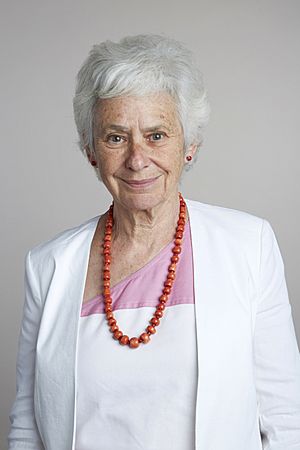Gail R. Martin facts for kids
Quick facts for kids
Gail Roberta Martin
|
|
|---|---|

Martin in 2015
|
|
| Born |
Gail Roberta Zuckman
1944 (age 80–81) Bronx, New York, U.S.
|
| Alma mater |
|
| Spouse(s) | G. Steven Martin (m. 1969) |
| Children | 1 son |
| Awards | Member, US National Academy of Sciences; Foreign Member, Royal Society; Pearl Meister Greengard Prize; E.G. Conklin Medal |
| Scientific career | |
| Fields | Developmental Biology |
| Institutions | University of California, San Francisco (UCSF) |
Gail Roberta Martin (born in 1944) is an American scientist who studies biology. She is a professor at the University of California, San Francisco (UCSF). She is famous for her important work on stem cells. She was the first to use the term 'embryonic stem cells'. Her research also helped us understand how certain growth factors work in developing bodies.
Contents
Early Life and Learning
Gail Martin grew up in The Bronx, New York. She was the only child of a pharmacist and a teacher. She finished high school in 1960. Then, she studied Zoology at the University of Wisconsin. In 1964, she went to the University of California, Berkeley (UCB) for her advanced studies.
During her time at UCB, a big student protest called the Free Speech Movement happened. Gail and other students spent a lot of time discussing and joining in these activities. She earned her Ph.D. in 1971. Her research focused on how cells grow. While studying, she married Steven Martin, another scientist.
A Career in Science
Discovering Stem Cells
After her studies, Gail Martin moved to London. In 1973, she worked with scientist Martin J. Evans. They studied special cells found in tumors called teratocarcinomas. These tumors contain pluripotent stem cells. Pluripotent cells are like blank slates; they can turn into any type of cell in the body.
Gail Martin created a way to keep these special cells alive. She also found a method to make them change into different cell types. This important work helped other scientists later. It made it possible to find pluripotent stem cells from normal mouse and human embryos.
Research at UCSF
In 1976, Martin joined the UCSF faculty. She started her own laboratory. Her biggest achievement was finding pluripotent stem cells from normal mouse embryos. Other scientists, Evans and Kaufman, also did this around the same time.
Martin and her team used advanced genetic methods. They showed how important fibroblast growth factors (FGF) are. These factors help many organs, like limbs, develop. Her lab also studied how the body controls FGF signals. This research showed how sensitive development is to even small changes in these signals.
Helping Other Scientists
While at UCSF, Martin led the Graduate Program in Developmental Biology for many years. She also helped create an online database. This database describes all the genetically changed mice at UCSF.
This online tool helps researchers find specific mouse models. It saves them time and money. It also encourages scientists to work together.
Awards and Recognition
Gail Martin has received many honors for her work. She won the American Cancer Society Faculty Research Award. She also received a Guggenheim Fellowship. In 2002, she was given the Edwin Grant Conklin Medal.
Other awards include the Pearl Meister Greengard Prize in 2007. She also received the FASEB Excellence in Science Award in 2011. University College London gave her an honorary doctorate in 2011.
She has given many special lectures around the world. She was also the President of the Society for Developmental Biology. She is a member of the American Academy of Arts and Sciences. She is also a member of the US National Academy of Sciences and a Foreign Member of the Royal Society.

